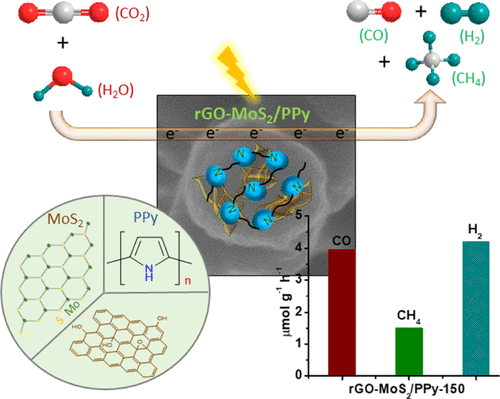当前位置:
X-MOL 学术
›
ACS Appl. Energy Mater.
›
论文详情
Our official English website, www.x-mol.net, welcomes your
feedback! (Note: you will need to create a separate account there.)
Polypyrrole-Promoted rGO–MoS2 Nanocomposites for Enhanced Photocatalytic Conversion of CO2 and H2O to CO, CH4, and H2 Products
ACS Applied Energy Materials ( IF 5.4 ) Pub Date : 2020-09-10 , DOI: 10.1021/acsaem.0c01602 Neeraj Kumar 1 , Santosh Kumar 2 , Rashi Gusain 1, 3 , Ncholu Manyala 4 , Salvador Eslava 2 , Suprakas Sinha Ray 1, 3
ACS Applied Energy Materials ( IF 5.4 ) Pub Date : 2020-09-10 , DOI: 10.1021/acsaem.0c01602 Neeraj Kumar 1 , Santosh Kumar 2 , Rashi Gusain 1, 3 , Ncholu Manyala 4 , Salvador Eslava 2 , Suprakas Sinha Ray 1, 3
Affiliation

|
Advanced functionalized nanomaterials are indispensable for the efficient production of solar fuels via the reduction of CO2 under solar light. This approach simultaneously addresses two major issues: (a) global warming due to anthropogenic CO2 production and (b) the ongoing energy crisis. Owing to their high catalytic activity and visible-light absorption, MoS2 has recently emerged as a suitable candidate for the photocatalytic production of solar fuels from water splitting and CO2 reduction. However, it currently shows poor conversion efficiency because of low adsorption of reactant gases, fast radiative recombination, and low chemical stability; these factors limit their practical applicability. In this work, CO2 photoreduction and H2 production were enhanced by integrating photoabsorber MoS2 and N-containing conducting polymer polypyrrole (PPy) on reduced graphene oxide (rGO). rGO–MoS2/PPy nanocomposites with various amounts of PPy were fabricated and morphologically, structurally, and optically characterized using several techniques. The optimal rGO–MoS2/PPy nanocomposite was found to exhibit a remarkable production of CO (3.95 μmol g–1 h–1), CH4 (1.50 μmol g–1 h–1), and H2 (4.19 μmol g–1 h–1) in the photocatalytic reduction of CO2 in an aqueous suspension under simulated sunlight. The enhanced photocatalytic performance of the nanocomposites was attributed to the beneficial combination of the rGO skeleton, MoS2 nanosheets, and in situ polymerized conductive PPy; this effectively promoted charge transfer, delayed recombination, improved light absorption, and CO2 adsorption. In summary, this study describes an inexpensive non-noble metal photocatalyst with three components for the efficient photoreduction of CO2 into clean solar fuels.
中文翻译:

聚吡咯促进的rGO-MoS 2纳米复合材料,用于增强CO 2和H 2 O的光催化转化为CO,CH 4和H 2产物
先进的功能化纳米材料对于通过在太阳光下还原CO 2来高效生产太阳能燃料必不可少。该方法同时解决了两个主要问题:(a)由于人为产生的CO 2产生的全球变暖以及(b)持续的能源危机。由于它们的高催化活性和可见光吸收性,MoS 2最近成为由水分解和CO 2光催化生产太阳能燃料的合适候选物。减少。然而,由于反应气体的低吸附,快速的辐射复合以及低的化学稳定性,目前显示出较低的转化效率。这些因素限制了它们的实际适用性。在这项工作中,通过将光吸收剂MoS 2和含氮的导电聚合物聚吡咯(PPy)集成在还原的氧化石墨烯(rGO )上,可以提高CO 2的光还原和H 2的产生。具有多种PPy的rGO–MoS 2 / PPy纳米复合材料的制备,形态,结构和光学表征均采用多种技术。发现最佳的rGO–MoS 2 / PPy纳米复合材料表现出显着的CO生成(3.95μmolg –1 h –1),CH 4(1.50μmolg –1 h –1)和H 2(4.19μmolg –1 h –1)在模拟阳光下水悬浮液中的CO 2光催化还原中。纳米复合材料增强的光催化性能归因于rGO骨架,MoS 2纳米片和原位聚合导电PPy的有益结合。这有效地促进了电荷转移,延迟重组,改善了光吸收和CO 2吸附。总而言之,这项研究描述了一种廉价的具有三种成分的非贵金属光催化剂,可有效地将CO光还原。2成清洁的太阳能。
更新日期:2020-10-26
中文翻译:

聚吡咯促进的rGO-MoS 2纳米复合材料,用于增强CO 2和H 2 O的光催化转化为CO,CH 4和H 2产物
先进的功能化纳米材料对于通过在太阳光下还原CO 2来高效生产太阳能燃料必不可少。该方法同时解决了两个主要问题:(a)由于人为产生的CO 2产生的全球变暖以及(b)持续的能源危机。由于它们的高催化活性和可见光吸收性,MoS 2最近成为由水分解和CO 2光催化生产太阳能燃料的合适候选物。减少。然而,由于反应气体的低吸附,快速的辐射复合以及低的化学稳定性,目前显示出较低的转化效率。这些因素限制了它们的实际适用性。在这项工作中,通过将光吸收剂MoS 2和含氮的导电聚合物聚吡咯(PPy)集成在还原的氧化石墨烯(rGO )上,可以提高CO 2的光还原和H 2的产生。具有多种PPy的rGO–MoS 2 / PPy纳米复合材料的制备,形态,结构和光学表征均采用多种技术。发现最佳的rGO–MoS 2 / PPy纳米复合材料表现出显着的CO生成(3.95μmolg –1 h –1),CH 4(1.50μmolg –1 h –1)和H 2(4.19μmolg –1 h –1)在模拟阳光下水悬浮液中的CO 2光催化还原中。纳米复合材料增强的光催化性能归因于rGO骨架,MoS 2纳米片和原位聚合导电PPy的有益结合。这有效地促进了电荷转移,延迟重组,改善了光吸收和CO 2吸附。总而言之,这项研究描述了一种廉价的具有三种成分的非贵金属光催化剂,可有效地将CO光还原。2成清洁的太阳能。











































 京公网安备 11010802027423号
京公网安备 11010802027423号